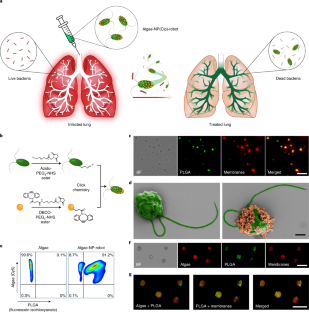2024-06-12 カリフォルニア大学サンディエゴ校(UCSD)
<関連情報>
- https://today.ucsd.edu/story/swimming-microrobots-deliver-cancer-fighting-drugs-to-metastatic-lung-tumors-in-mice
- https://www.science.org/doi/10.1126/sciadv.adn6157
- https://www.nature.com/articles/s41563-022-01360-9
バイオハイブリッドマイクロロボットが薬剤入りナノ粒子を局所的かつ能動的に送達し、肺転移の進行を抑制する Biohybrid microrobots locally and actively deliver drug-loaded nanoparticles to inhibit the progression of lung metastasis
FANGYU ZHANG, ZHONGYUAN GUO, ZHENGXING LI, HAO LUAN, […], AND JOSEPH WANG
Science Advances Published:12 Jun 2024
DOI:https://doi.org/10.1126/sciadv.adn6157

Abstract
Lung metastasis poses a formidable challenge in the realm of cancer treatment, with conventional chemotherapy often falling short due to limited targeting and low accumulation in the lungs. Here, we show a microrobot approach using motile algae for localized delivery of drug-loaded nanoparticles to address lung metastasis challenges. The biohybrid microrobot [denoted “algae-NP(DOX)-robot”] combines green microalgae with red blood cell membrane–coated nanoparticles containing doxorubicin, a representative chemotherapeutic drug. Microalgae provide autonomous propulsion in the lungs, leveraging controlled drug release and enhanced drug dispersion to exert antimetastatic effects. Upon intratracheal administration, algae-NP(DOX)-robots efficiently transport their drug payload deep into the lungs while maintaining continuous motility. This strategy leads to rapid drug distribution, improved tissue accumulation, and prolonged retention compared to passive drug-loaded nanoparticles and free drug controls. In a melanoma lung metastasis model, algae-NP(DOX)-robots exhibit substantial improvement in therapeutic efficacy, reducing metastatic burden and extending survival compared to control groups.
急性細菌性肺炎を治療するための生体内抗生物質デリバリーのためのナノ粒子修飾マイクロロボット Nanoparticle-modified microrobots for in vivo antibiotic delivery to treat acute bacterial pneumonia
Fangyu Zhang,Jia Zhuang,Zhengxing Li,Hua Gong,Berta Esteban-Fernández de Ávila,Yaou Duan,Qiangzhe Zhang,Jiarong Zhou,Lu Yin,Emil Karshalev,Weiwei Gao,Victor Nizet,Ronnie H. Fang,Liangfang Zhang & Joseph Wang
Nature Materials Published:22 September 2022
DOI:https://doi.org/10.1038/s41563-022-01360-9

Abstract
Bioinspired microrobots capable of actively moving in biological fluids have attracted considerable attention for biomedical applications because of their unique dynamic features that are otherwise difficult to achieve by their static counterparts. Here we use click chemistry to attach antibiotic-loaded neutrophil membrane-coated polymeric nanoparticles to natural microalgae, thus creating hybrid microrobots for the active delivery of antibiotics in the lungs in vivo. The microrobots show fast speed (>110 µm s-1) in simulated lung fluid and uniform distribution into deep lung tissues, low clearance by alveolar macrophages and superb tissue retention time (>2 days) after intratracheal administration to test animals. In a mouse model of acute Pseudomonas aeruginosa pneumonia, the microrobots effectively reduce bacterial burden and substantially lessen animal mortality, with negligible toxicity. Overall, these findings highlight the attractive functions of algae–nanoparticle hybrid microrobots for the active in vivo delivery of therapeutics to the lungs in intensive care unit settings.


